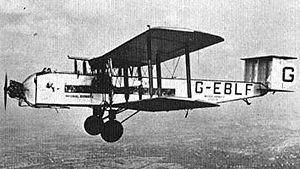Top speed 178 km/h Length 20 m | Wingspan 27 m First flight March 1926 | |
 | ||
Manufacturers Armstrong Whitworth Aircraft, Armstrong Whitworth | ||
Armstrong whitworth argosy
The Armstrong Whitworth Argosy was a British three-engine biplane airliner built by Armstrong Whitworth Aircraft, and operated by Imperial Airways from 1926 to 1935.
Contents
- Armstrong whitworth argosy
- Armstrong whitworth argosy in nelson mid 1980 s
- Development
- Operational history
- Variants
- Operators
- Specifications Argosy II
- References
Armstrong whitworth argosy in nelson mid 1980 s
Development
The Armstrong Whitworth A.W.154 Argosy stemmed from a declaration by Imperial Airways that all its aircraft would be multi-engine designs, on the grounds of safety. They were intended to replace the older single-engine de Havilland aircraft that Imperial Airways had inherited from its constituent companies, mainly Daimler Airway. The first example (G-EBLF) flew in March 1926, following an initial order for three Argosys from Imperial Airways. An improved Mk. II version was introduced in 1929.
Operational history
The Argosy was initially used on European routes (later operating on services to South Africa), with the fleet named after cities. The first passenger flight was from London to Paris on 16 July 1926. Argosies implemented the world's first "named" air service, the luxury 'Silver Wing' service from London to Paris, using Argosy City of Birmingham (G-EBLO). Two seats were removed, and replaced with a bar, and a steward was in attendance. In April 1931 Edward, Prince of Wales and his brother Prince George flew home from Paris–Le Bourget Airport in City of Glasgow (G-EBLF), which landed specially in Windsor Great Park.
Three Argosys were lost during service with Imperial Airways, one being written off in a forced landing near Aswan, and one during a training accident, both in 1931, with no injuries in either accident. On 28 March 1933, however, the City of Liverpool caught fire over Belgium, causing a crash in which all three crew and twelve passengers were killed. This aircraft is featured in the Michael Powell film Red Ensign.
Argosys continued in service with Imperial Airways until 1935, with the last example, City of Manchester (G-AACJ), being used for joy-riding by United Airways Ltd of Stanley Park Aerodrome (Blackpool), which later was merged into British Airways Ltd. It continued in use with British Airways until December 1936.
Variants
Operators
Specifications (Argosy II)
Data from British Civil Aircraft since 1919.
General characteristics
Performance
